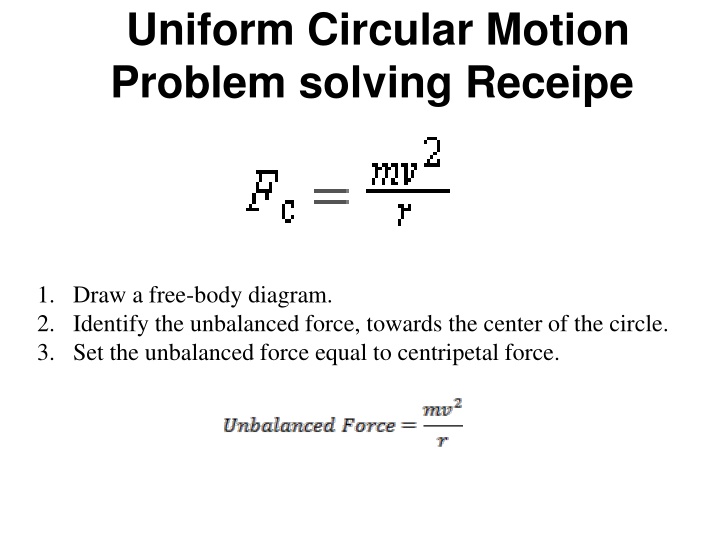
Physics Problem Solving Techniques for Circular Motion
Explore various physics problems and solutions related to uniform circular motion, including free-body diagrams, centripetal force calculations, and real-world applications like car and jet movements. Enhance your understanding of forces and motion in circular paths.
Download Presentation

Please find below an Image/Link to download the presentation.
The content on the website is provided AS IS for your information and personal use only. It may not be sold, licensed, or shared on other websites without obtaining consent from the author. If you encounter any issues during the download, it is possible that the publisher has removed the file from their server.
You are allowed to download the files provided on this website for personal or commercial use, subject to the condition that they are used lawfully. All files are the property of their respective owners.
The content on the website is provided AS IS for your information and personal use only. It may not be sold, licensed, or shared on other websites without obtaining consent from the author.
E N D
Presentation Transcript
Uniform Circular Motion Problem solving Receipe 1. Draw a free-body diagram. 2. Identify the unbalanced force, towards the center of the circle. 3. Set the unbalanced force equal to centripetal force.
Car on a Flat-Curve Problem: At what maximum speed can a car safely negotiate a horizontal unbanked turn (radius = 51 m) in dry weather (coefficient of static friction = 0.95)?
Banked Curves 26. What is the ideal speed to take a 100 m radius curve banked at a 20.0 angle?
Banked Curves 26. What is the ideal speed to take a 100 m radius curve banked at a 20.0 angle?
Problem A jet flying at 123 m/s banks to make a horizontal circular turn. The radius of the turn is 3810 m, and the mass of the jet is 2.00 x 10^5 kg. Calculate the magnitude of the necessary lifting force.
Changes in Normal Force as a Car moves along a Flat, Dip, and Hilly road
Acceleration Due to Gravity Calculate the surface gravity for a planet Earth. Gravitational constant = G = 6.673 x 10-11N.m2/kg2. Mass of Earth = 5.98 x 1024kg. Mean Radius of Earth = 6380 km.
Satellites in Circular Orbits Determine the speed of the ISS, orbiting the Earth, at an altitude of 390 km above ground. Gravitational constant = G = 6.673 x 10-11N.m2/kg2. Mass of Earth = 5.98 x 1024kg. Mean Radius of Earth = 6380 km.
